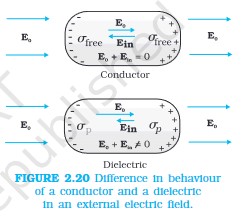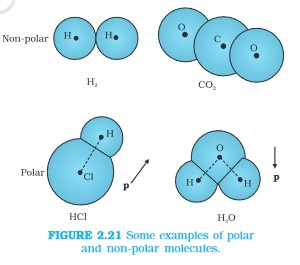Physics Electrostatic Potential and Capacitance Class 12 Notes: CBSE Class 12 Chapter 2 Physics Electrostatic Potential and Capacitance explores the fundamental concepts of electric charges, Coulomb's law, and electric field due to point charges and dipoles. It will help you get the concept of Gauss's law, electric potential, capacitance, and the behaviour of dielectrics. You study conductors, insulators, and capacitance of parallel plate capacitors, analyse the energy stored in an electric field and its applications to gain insights into electric flux and its relevance in Gauss's law. His chapter helps the students develop a comprehensive understanding of the principles governing electric charges and their interactions within various fields. In this article, you can get the complete chapter notes of Ch 1 Electrostatic Potential and Capacitance from CBSE 12th class Physics.
Related:
Also Check:
CBSE 12th Physics Chapter 2 Electrostatic Potential and Capacitance Class 12 Notes
| 2.2 ELECTROSTATIC POTENTIAL
2.3 POTENTIAL DUE TO A POINT CHARGE
2.4 POTENTIAL DUE TO AN ELECTRIC DIPOLE The electrostatic potential at a point with position vector r due to a point dipole of dipole moment p placed at the origin is The result is true also for a dipole (with charges –q and q separated by 2a) for r >> a. 2.5 POTENTIAL DUE TO A SYSTEM OF CHARGES For a charge configuration q1, q2, ..., qn with position vectors r1, r2, ... rn, the potential at a point P is given by the superposition principle where r1P is the distance between q1 and P, as and so on.
2.6 EQUIPOTENTIAL SURFACES An equipotential surface is a surface over which potential has a constant value. For a point charge, concentric spheres centred at a location of the charge are equipotential surfaces. The electric field E at a point is perpendicular to the equipotential surface through the point. E is in the direction of the steepest decrease of potential.
For a single charge q, the potential is given by
2.6.1 Relation between field and potential The relation between electric field (E) and electric potential (V) is given by the following equation: E = - dV/dx Where: - E is the electric field strength at a particular point in space. - V is the electric potential at that point. - dx is the infinitesimal displacement along the x-direction. It means that the electric field points in the direction of the steepest decrease in electric potential. Electric potential is a scalar quantity, whereas the electric field is a vector quantity. The direction of the electric field is from higher potential to lower potential. Therefore, when moving in the direction of the electric field, the electric potential decreases. Conversely, if one moves against the electric field, the electric potential increases. 2.7 POTENTIAL ENERGY OF A SYSTEM OF CHARGES For charges Q1 an Q2
For a system of 3 charges:
2.8 POTENTIAL ENERGY IN AN EXTERNAL FIELD 2.8.1 Potential energy of a single charge Work done in bringing a charge q from infinity to the point P in the external field is qV. This work is stored in the form of potential energy of q. If the point P has position vector r relative to some origin, we can write: Potential energy of q at r in an external field = qV (r), where V(r) is the external potential at the point r. 2.8.2 Potential energy of a system of two charges in an external field Potential energy of a system of two charges q1 and q2 located at r1and r2 2.8.3 Potential energy of a dipole in an external field The potential energy of a dipole moment p in a uniform electric field E is –p.E. 2.9 ELECTROSTATICS OF CONDUCTORS
2.10 DIELECTRICS AND POLARISATION Dielectrics are non-conducting substances. Difference in behaviour of a conductor and a dielectric in an external electric field:
Polar molecules: centres of positive and negative charges are separated and have permanent dipole moments. Non-polar molecules:Centres of positive andnegative charges coincide and have no permanent dipole moment.
A uniformly polarised dielectric amounts to induced surface charge density, but no volume charge density.
2.11 CAPACITORS AND CAPACITANCE
2.12 THE PARALLEL PLATE CAPACITOR A parallel plate capacitor consists of two large plane parallel conducting plates separated by a small distance. For a parallel plate capacitor (with vacuum between the plates),
where A is the area of each plate and d the separation between them. 2.13 EFFECT OF DIELECTRIC ON CAPACITANCE If the medium between the plates of a capacitor is filled with an insulating substance (dielectric), the electric field due to the charged plates induces a net dipole moment in the dielectric. This effect, called polarisation, gives rise to a field in the opposite direction. The net electric field inside the dielectric and hence the potential difference between the plates is thus reduced. Consequently, the capacitance C increases from its value C0 when there is no medium (vacuum), C = KC0 where K is the dielectric constant of the insulating substance. 2.14 COMBINATION OF CAPACITORS 2.14.1 Capacitors in series and 2.14.2 Capacitors in parallel
2.15 ENERGY STORED IN A CAPACITOR
|
CBSE Electrostatic Potential and Capacitance Class 12 Notes PDF Download
Download CBSE Class 12 Physics Ch 2 Electrostatic Potential and Capacitance Notes PDF |
Related:
Also Check:







Comments
All Comments (0)
Join the conversation